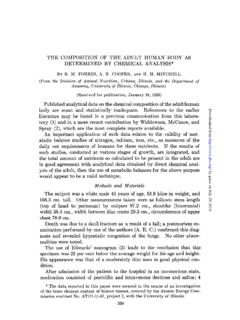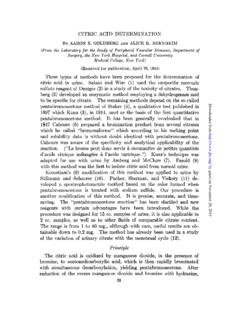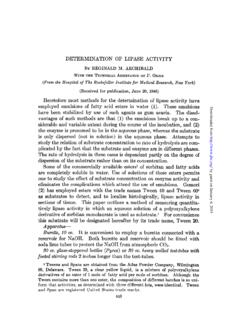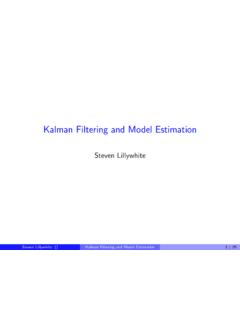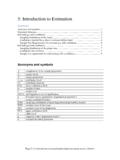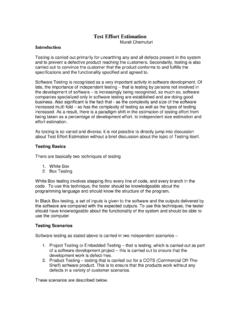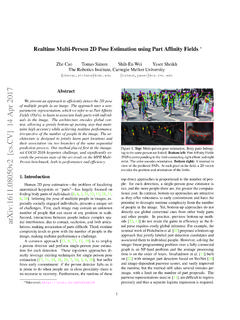Transcription of THE DETECTION AND ESTIMATION OF REDUCING SUGARS. …
1 THE DETECTION AND ESTIMATION OF REDUCING SUGARS. BY STANLEY R. BENEDICT. (From the Shefield Laboratory of Physiological Chemistry, Yale University.) (Received for publication, March 23, IgoT.) THE DETECTION OF SUGARS. Of the extremely large number of methods proposed for the DETECTION of REDUCING sugars there are very few which may be regarded as specific for sugars alone. With one or two possible exceptions, these tests indicate only the presence or absence of REDUCING substances, and are inapplicable to the DETECTION of sugars when other REDUCING substances are present. The fact that many of the sugars are powerful REDUCING agents in alkaline solutions, while they exert, at most, slight action in neutral or acid solutions, is very commonly recognized, and application is made of this fact in almost every test which has been pro- posed for the DETECTION of these substances.
2 Gaud, Framm and others1 have made studies of the effect of alkali upon a number of the sugars. The substances formed appear to be oxidation products, possibly preceded by a dehy- dration and decomposition. The destructive action of alkalies upon glucose is a common matter of reference throughout the literature upon the ESTIMATION of sugars, and numerous sugges- tions have been made to avoid this difficulty by means of the substitution of ammonium hydroxide for potassium or sodium hydroxide, and keeping the temperature somewhat below the boiling point during the reaction, with other devices of a similar The following experiments were undertaken to throw light upon the mechanism of the REDUCING action of the sugars in alka- 1 See De Bruyn and Ekenstein: Rec. Trav. Chem., xvi, p.
3 274, 1897; Framm: Arch. f. d. ges. Physiol., Ixiv, p. 57 5,18g6, and Gaud: Compt. rend. de 1 Acad. des xi., cxix, p. 650, 1894. 2 See Gaud: 106. cit. 101 by guest on August 19, 2018 from 102 DETECTION and ESTIMATION of Sugars line solution as well as to test the relative destructive action of certain of the alkalies upon various carbohydrates. A I per cent solution of dextrose was boiled for about aminute with one- half its volume of a IO per cent potassium hydroxide solution, the resulting solution cooled to room temperature and added to an equal volume of ordinary Fehling s solution, also at room temperature. No change occurred in the mixture in the cold, and only a very faint reduction was obtained upon boiling. Clearly the sugar had been practically completely oxidized, so far at least as its power of affecting Fehling s solution was con- cerned.
4 This result was rather what might have been expected, inasmuch as we are here dealing with one of the most readily oxidized of the carbohydrates. In the next experiment a solution of lactose was substituted for the dextrose. Upon adding an equal volume of Fehling s solution to the cooled solution a heavy reduction of the copper occurred almost instantaneously in the cold. Five cubic centimeters of a I per cent solution of dextrose were now heated to boiling with about gram of sodium carbonate, the resulting solution cooled, and mixed with an equal volume of Fehling s solution. An almost instantaneous reduction of the copper compound occurred, as indicated by a heavy precipita- r The only references which I have been able to find relating to the for- mation of a compound capable of REDUCING Fehling s solution in the cold as a result of warming sugars with alkali, are in Kiihne s Lekrbuck der physiologischen Ckemie (p.)
5 5 18, 1868), in the work of Worm Mtiller and Hagen (Arch. f. d. ges. Pkysiol., xxii, p. 39 I, ISSO), and of Emmerling and Loges (Arch. f. d. ges. Pkysiol., xxiv, p. 184,r881). Ktihne states that dex- trose solutions, heated to about 70~ C. with sodium or potassium hydroxide solution will yield a solution capable of REDUCING Fehling s solution in the cold. He suggests this fact as evidence that the sugars themselves do not reduce directly and suggests this procedure as a test for dextrose in the urine. Worm Miiller and Hagen discuss the bearing of this fact upon Trommer s test for dextrose in the urine. Emmerling and Loges come to the conclusion that the REDUCING substance formed is acetone alcohol, CHsCO-CHaOH. At the time my work was done the statement of Kiihne on this subject was unknown to me, and inasmuch as neither he nor Worm Mtiller made comparisons of the action of the other alkalies and other sugars, nor gave a full theoretical discussion or analytical appli- cation of the fact which they stated, I have thought it desirable to give a rather complete discussion of my results.
6 By guest on August 19, 2018 from Stanley R. Benedict 103 tion of the yellow cuprous oxide. A solution of lactose substi- tuted for the dextrose in the above experiment yielded a similar result. In other words, a I per cent solution of glucose boiled for a few moments with IO per cent potassium hydroxide solu- tion almost completely loses its REDUCING power. A similar treat- ment of a lactose solution yields a solution containing some sub- stances capable of REDUCING Fehling s solution in the cold. Boil- ing either lactose or dextrose with sodium carbonate yields a solution which reduces Fehling s in the cold. It is particularly to be noted here that the potassium hydroxide solution destroys the REDUCING power of the dextrose, while the carbonate, under similar conditions, does not.
7 This fact will be referred to later. The compound formed under these conditions is remarkably strong in its REDUCING power. Ammoniacal silver solutions are reduced instantaneously and completely in the cold. The prod- uct formed either from dextrose or lactose is capable of REDUCING Barfoed s reagent upon boiling, even when the acidity is consider- ably greater than that called for in Barfoed s formula. These results indicate that the sugars themselves are not directly responsible for the strong REDUCING action of their alka- line solutions. They also admit of some valuable analytical applications. The first of such applications would be appar- ently to afford a differentiation of lactose from dextrose, the former substance in I per cent solution forming a compound upon boiling with alkali which will reduce Fehling s fluid in the cold, while dextrose under similar conditions is destroyed.
8 This appli- cation can be made, and by means of such a method it is possible to detect lactose in presence of dextrose, or to distinguish between dextrose and lactose solutions. The procedure is as follows: To about S-IO cubic centimeters of the solution to be tested is added one-half volume of IO per cent potassium hydroxide solu- tion and the resulting mixture boiled vigorously for about one and one-half minutes. The solution is then cooled and added to an equal volume of Fehling s fluid. The immediate formation of a heavy precipitate which is bright yellow and fills the entire body of the solution indicates lactose. A slight precipitate is to be disregarded. The solution used for this test should contain between and I per cent of the sugar . It is not a par- ticularly delicate reaction and will not give positive results where by guest on August 19, 2018 from 104 DETECTION and ESTIMATION of Sugars the amount of lactose is under 25 per cent of the total quantity of sugar present.
9 A much wider analytical application of these facts is possible. Upon them we may base a reaction which is apparently specific for sugars. Very few, if any other substances will, upon boiling with alkalies, form substances capable of REDUCING Fehling s solu- tion in the cold. In just so far as this is true, this method of detecting sugars is specific. The procedure is as follows: To 5-8 cubic centimeters of the fluid to be tested in a test tube, is added about one-half gram of sodium carbonate. Heat the solution to boiling and continue the boiling for about one-half minute. Cool and add an equal volume of Fehling s solution. If sugar is present a reduction will occur more or less promptly, one per cent or more giving a practically instantaneous reaction, smaller amounts requiring from three to five minutes.
10 As thus carried out this method will detect sugar in solutions containing per cent, or more, of sugar . Slightly warming the tube will increase the delicacy to about per cent. These figures apply to relatively pure solutions of the sugars. While this method is not nearly so sensitive as the usual Fehling s method, it may become of material use in establishing the presence or absence of sugars in mixtures containing other REDUCING substances, and is delicate enough for many purposes. Attention was called above to the fact that sodium hydroxide solutions destroy the REDUCING properties of glucose much more rapidly than does sodium carbonate solution. Yet the alkalin- ity given by sodium carbonate is amply sufficient for the glucose to exhibit its full REDUCING action. Considering the bearing of these facts upon sugar DETECTION it will be evident that where only very small amounts of dextrose are present, or where some l It is not to be inferred from this statement that a distinction is implied between the action of the hydroxides and carbonates in any respect other than may be accounted for by the difference in the degree of alkalinity represented by the two substances.

